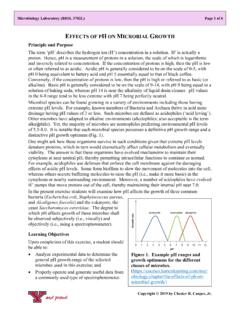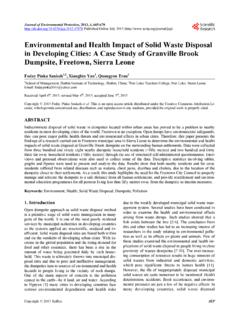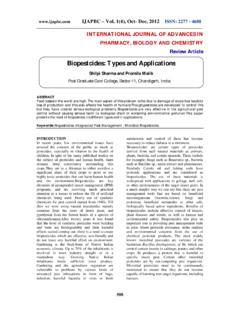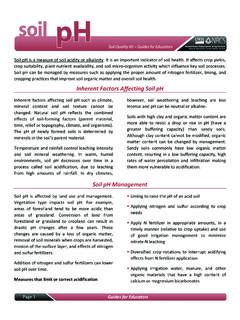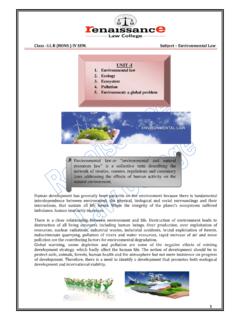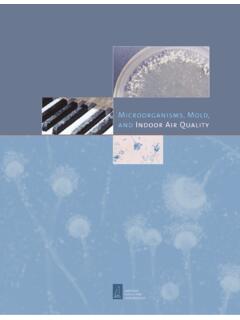Transcription of Microbiological Aspects of Cleaning Validation
1 Dr. Tim Sandle Pharmaceutical Microbiology Resources: Microbiological Aspects of Cleaning Validation Introduction Cleaning Cleaning Validation & GMPs Microbiological concerns Microbiological risks Risk assessment Microbiological tests and acceptance criteria Why failures happen What is Cleaning ? Cleaning is assessed based on the level of residues that remain, either those directly found on the equipment or those indirectly contained within the final rinse after water has passed through or over the equipment. Whether the residues remaining have been reduced to a satisfactory low level is based on predetermined acceptance criteria.
2 An additional concern is with the microbial bioburden. Cleaning Validation Cleaning Validation - methodology applied to give the assurance that a Cleaning process has removed residues and contaminants from a piece of equipment or machinery. Residues: Microorganisms Active pharmaceutical ingredients Other process chemicals, such as buffers Cleaning agents themselves (detergents) Microbiological culture media The Validation aspect refers to providing documented evidence that that the acceptance criteria have been met. Relative risks manual vs automated Cleaning Manual Cleaning is inherently high-risk compared with automated Cleaning .
3 There will be variations between each cleaner. Variations of time. Variations with quantities of Cleaning chemicals used. Manual Cleaning procedures may need to be monitored and maintained. GMPs #1 Code of Federal Regulations (CFR): PART 111--CURRENT GOOD MANUFACTURING PRACTICE INMANUFACTURING, PACKAGING, LABELING, OR HOLDING OPERATIONS FOR DIETARY SUPPLEMENTS (d) You must maintain, clean, and sanitize, as necessary, all equipment, utensils, and any other contact surfaces used to manufacture, package, label, or hold components or dietary supplements. PART 211 -- CURRENT GOOD MANUFACTURING PRACTICE FOR FINISHED PHARMACEUTICALS Equipment Cleaning and maintenance PART 820 QUALITY SYSTEM REGULATION GMPs #2 FDA, Guide to Inspections Validation of Cleaning Processes.
4 (Silver Spring, MD, 1993). Pharmaceutical Inspection Convention/Pharmaceutical Inspection Co-Operation Scheme (PIC/S). Validation Master Plan Installation And Operational Qualification Non-Sterile Process Validation Cleaning Validation . (Geneva, Switzerland, Sept., 2009). Number of runs? No direct guidance relating to the number of runs. By convention, three runs are normally performed in order to demonstrate that the obtained results are not due to chance. microbial Aspects microbial Aspects #1 The chemical verification of Cleaning Validation is relatively well described. What is often less clear is the Microbiological aspect.
5 Divided into: The microorganisms themselves (a direct hazard) The presence of residues that potentially provide a microbial growth source (an indirect hazard). To evaluate these Microbiological risks a sound Microbiological sampling plan is required. microbial Aspects #2 microbial Aspects #3 The processes that form part of Cleaning Validation have an impact upon microorganisms remaining post- Cleaning and on microbial survival. With cleanrooms, humidity control is recommended for areas where equipment is held and stored in order to reduce the level of moisture (given that moist environments support the survival and growth of many microorganisms and there is a particular association with Gram-negative bacteria and fungi).
6 The microbiologist should input. Cleaning chemicals and microbial survival #1 The types of Cleaning agents selected will have different affects upon microorganisms depending on the nature of chemical and the species (and numbers) of microorganisms present on a given surface. These Cleaning agents, which are typically one caustic based agent (sodium hydroxide) and one acid based reagent (such as hydrochloric acid), should be included as part of the Cleaning Validation . Many commercial Cleaning agents are formulated Cleaning (in addition to water) with a surfactant, an alkalinity source (such as sodium hydroxide), and a chelant.
7 Acid and caustic? There is a recurrent discussion about the need for both an acid and a caustic for Cleaning Validation . Alkaline detergents are good for removing organic soils, oils, fats, proteins, starches, and carbohydrates. They hydrolyze peptide bonds and breaking down large, insoluble proteins into small, more easily soluble polypeptides. Alkaline reagents are good for microbial kill. Theoretically Microbiological contamination, including viral residues, can be overcome by using sodium hydroxide in the Cleaning process. Sodium hydroxide dissolves proteinaceous soils and fatty oils by saphonification.
8 Sodium hydroxide effectively dissolves protein and organic matter. Acid and caustic? The use of an acid depends on which impurities are of a concern, and whether these will act as a barrier for the alkaline agent and protect microorganisms. Acid detergents do not work well on heavy soils, oils, and glucans. Phosphoric acid is useful in removing protein residues Acid detergents are effective for the prevention or removal of water scale (calcium and magnesium carbonates), and aluminium oxide. They are also good at bacteria kill, but they are rarely used without alkaline detergents. Cleaning chemicals and microbial survival #2 Cleaning agents should not be seen as disinfecting in the sense that disinfection is defined as the known reduction of a population of microorganisms as demonstrated through controlled laboratory studies.
9 Other Aspects of the Cleaning process can prove hostile to microbial survival: Temperature of the water used for Cleaning (above 60oC) pH ranges below 4 and above 11. Effect of water rinses #1 Water is a key part of Cleaning Validation . Water rinses will remove Cleaning chemicals and will siphon away any microorganisms in the planktonic state. Water is: Capable of wetting surface to penetrate the soil deposit Has the capacity to break the soil into fine particles Water holds small fine particles into suspension Water can prevent residues from redepositing onto a cleaned surface Effect of water rinses #2 Final water rinse is Water of Injections (this is for all types of pharmaceutical products).
10 Water must meet the required Microbiological specification with WFI NMT 10 CFU/100mL for bioburden and NMT EU/mL for bacterial endotoxin. Following rinsing equipment should not be left with residual water after Cleaning . The last step of the Cleaning procedure involve drying, perhaps with the addition of a solvent (such as 70% sterile isopropyl alcohol) or flushing with sterile compressed air. Critical process and quality parameters Critical process parameters for Cleaning Validation are: Time (dirty and clean hold times and process run time). Activity (chemical exposure, number of water rinses etc).

